Electromagnetic flow meters are highly efficient and reliable instruments for measuring volumetric flow, widely used in various industrial and environmental monitoring applications. Thanks to their unique working principles and structural design, electromagnetic flow meters offer several significant advantages, making them the preferred choice for flow measurement in many industries. Below are the key benefits of using electromagnetic flow meters.

1. Minimal Impact from Fluid Properties, High Adaptability
Electromagnetic flow meters are not significantly affected by the temperature, viscosity, density, or conductivity of the measured medium (within certain limits). This feature ensures that electromagnetic flow meters can be used to measure the flow of a wide range of conductive liquids without additional calibration for different fluids. Notably, after calibration with water, the flow meter can be used to measure the flow of other conductive liquids, saving time and improving accuracy across various applications.
2. Simple Structure, Reduced Flow Resistance
Electromagnetic flow meters have a simple transmitter structure with no moving parts or throttling components. This design eliminates additional resistance during fluid flow, ensuring that there is no extra pressure loss when the fluid passes through. Moreover, the absence of moving parts prevents issues such as wear and clogging. These characteristics make electromagnetic flow meters ideal for measuring two-phase flow, such as slurries or wastewater containing solid particles, as well as high-viscosity fluids like pulps.
3. Excellent Corrosion Resistance
Electromagnetic flow meters are equipped with no moving parts, allowing them to be constructed with corrosion-resistant liners or materials. This makes them suitable for measuring aggressive or corrosive fluids, such as chemicals or acid-base solutions. The high corrosion resistance of these materials ensures that electromagnetic flow meters perform reliably even in harsh environments, extending the service life of the instrument and maintaining measurement accuracy over time.
4. Wide Flow Range and Flow Independence
Electromagnetic flow meters feature an impressive flow range, typically achieving a rangeability of 1:100. This means they can accurately measure flow rates from very low to very high levels. Additionally, the measurement is directly proportional to the average flow velocity of the medium, independent of the flow regime (laminar or turbulent). This ensures that electromagnetic flow meters can provide stable and accurate readings regardless of variations in the flow conditions, making them versatile and reliable across different applications.
5. Fast Response and Suitable for Instantaneous Flow Measurement
Without mechanical inertia, electromagnetic flow meters have a fast response time, capable of accurately measuring instantaneous pulsing flow rates. Their measurement signals have a linear relationship with the flow, allowing for direct and linear conversion to standard output signals. These signals can be used for local indication or remote transmission, making electromagnetic flow meters ideal for applications that require real-time flow monitoring and control, such as industrial processes.
6. Low Maintenance Costs and High Reliability
Since electromagnetic flow meters do not rely on moving parts, they experience minimal wear and tear, reducing the likelihood of failures and lowering maintenance costs. Their simple design and high reliability ensure long-term stable performance, making them a durable and low-maintenance option for continuous flow measurement in various industries.
Electromagnetic flow meters, with their resistance to fluid property variations, absence of moving parts, wide flow range, and quick response time, are ideal for a wide array of industrial and environmental applications. Whether for measuring complex media or for flow monitoring in real-time, electromagnetic flow meters provide reliable and precise measurements. Their unique design not only enhances measurement efficiency but also reduces maintenance costs, making them the preferred solution for flow measurement in many fields.



